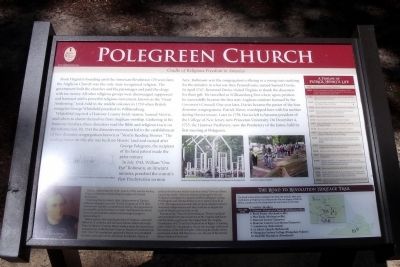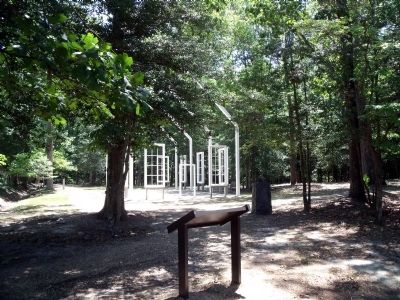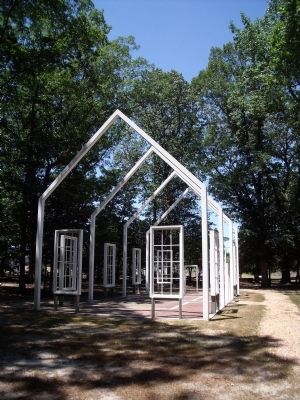Near Mechanicsville in Hanover County, Virginia — The American South (Mid-Atlantic)
Polegreen Church
Cradle of Religious Freedom in America
Whitefield inspired a Hanover County brick mason, Samuel Morris, and others to absent themselves from Anglican worship. Gathering in his home on Sundays, these dissenters read the Bible and religious tracts on reformation. By 1743 the dissenter movement led to the establishment of four dissenter congregations known as “Morris Reading Houses.” The reading house on this site was built on Morris’ land and named after George Polegreen, the recipient of the land patent made the prior century.
In July 1743, William “One Eye” Robinson, an itinerant minister, preached the county’s first Presbyterian sermon here. Robinson sent the congregation’s offering to a young man studying for the ministry in what was then Pennsylvania, named Samuel Davies. In April 1747, Reverend Davies visited Virginia to thank the dissenters for their gift. He travelled to Williamsburg first where upon petition he successfully became the first non-Anglican minister licensed by the Governor’s Council. One year later, Davies became the pastor of the four dissenter congregations. Patrick Henry worshipped here with his mother during Davies tenure. Later in 1759, Davies left to become president of the College of New Jersey, now Princeton University. On December 4, 1755, the Hanover Presbytery, now the Presbytery of the James, held its first meeting at Polegreen.
(sidebar)
Patrick Henry (May 29, 1736 – June 6, 1799) was the leading Virginia statesman in defending the rights of Colonial America.
Following Henry's death, John Adams wrote to Thomas Jefferson singing his praises: “In the Congress of 1774 there was not one member, except Patrick Henry, who appeared to me sensible of the Precipice or rather the Pinnacle on which he stood, and had the candour and courage enough to acknowledge it.”
Henry was the first elected governor of Virginia, a devoted father of 17 children, and the most famous orator of his day. Born in Hanover County, Henry made a name for himself as a young lawyer in the Parsons’ Cause at Hanover Courthouse in 1763. His 1765 resolutions against the Stamp Act articulated the basic principles of the American Revolution. Henry is perhaps best known for his
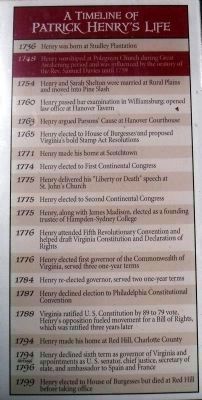
2. A Timeline of Patrick Henry's Life
1736 Henry was born at Studley Plantation
1748 Henry worshiped at Polegreen Church during Great Awakening period and was influenced by the oratory of the Rev. Samuel Davies until 1759
1754 Henry and Sarah Shelton were married at Rural Plains and moved into Pine Slash
1760 Henry passed bar examination in Williamsburg; opened law office at Hanover Tavern
1763 Henry argued Parsons’ Cause at Hanover Courthouse
1765 Henry elected to House of Burgesses and proposed Virginia’s bold Stamp Act Resolutions
1771 Henry made his home at Scotchtown
1774 Henry elected to First Continental Congress
1775 Henry delivered his “Liberty or Death” speech at St. Johns Church
1775 Henry elected to Second Continental Congress
1775 Henry, along with James Madison, elected as a founding trustee of Hampden-Sydney College
1776 Henry attended Fifth Revolutionary Convention and helped draft Virginia Constitution and Declaration of Rights
1776 Henry elected first governor of the Commonwealth of Virginia, served three one-year terms
1784 Henry re-elected governor, served two one-year terms
1787 Henry declined election to Philadelphia Constitutional Convention
1788 Virginia ratified U.S. Constitution by 89 to 79 vote, Henry’s opposition fueled movement for a Bill of Rights, which was ratified three years later
1794 Henry made his home at Red Hill, Charlotte County
1794 through 1796 Henry declined sixth term as governor of Virginia and appointments as U.S. senator, chief justice, secretary of state, and ambassador to Spain and France
1799 Henry elected to House of Burgesses but died at Red Hill before taking office
1748 Henry worshiped at Polegreen Church during Great Awakening period and was influenced by the oratory of the Rev. Samuel Davies until 1759
1754 Henry and Sarah Shelton were married at Rural Plains and moved into Pine Slash
1760 Henry passed bar examination in Williamsburg; opened law office at Hanover Tavern
1763 Henry argued Parsons’ Cause at Hanover Courthouse
1765 Henry elected to House of Burgesses and proposed Virginia’s bold Stamp Act Resolutions
1771 Henry made his home at Scotchtown
1774 Henry elected to First Continental Congress
1775 Henry delivered his “Liberty or Death” speech at St. Johns Church
1775 Henry elected to Second Continental Congress
1775 Henry, along with James Madison, elected as a founding trustee of Hampden-Sydney College
1776 Henry attended Fifth Revolutionary Convention and helped draft Virginia Constitution and Declaration of Rights
1776 Henry elected first governor of the Commonwealth of Virginia, served three one-year terms
1784 Henry re-elected governor, served two one-year terms
1787 Henry declined election to Philadelphia Constitutional Convention
1788 Virginia ratified U.S. Constitution by 89 to 79 vote, Henry’s opposition fueled movement for a Bill of Rights, which was ratified three years later
1794 Henry made his home at Red Hill, Charlotte County
1794 through 1796 Henry declined sixth term as governor of Virginia and appointments as U.S. senator, chief justice, secretary of state, and ambassador to Spain and France
1799 Henry elected to House of Burgesses but died at Red Hill before taking office
Known as the “Voice of the Revolution,” Henry’s political career included 26 years of service in the Virginia legislature and five terms as governor. He helped draft the Virginia Constitution of 1776 and its Declaration of Rights. A leading critic of the U.S. Constitution, Henry also strongly influenced the creation of the Bill of Rights. Following his death, Henry was buried at Red Hill Plantation, now the site of the Patrick Henry National Memorial.
Erected 2010 by The Road to Revolution Heritage Trail. (Marker Number 2.)
Topics and series. This historical marker is listed in these topic lists: Churches & Religion • Colonial Era • War, US Revolutionary. In addition, it is included in the Former U.S. Presidents: #02 John Adams, and the Former U.S. Presidents: #03 Thomas Jefferson series lists. A significant historical month for this entry is April 1747.
Location. 37° 38.713′ N, 77° 19.846′ W. Marker is near Mechanicsville, Virginia, in Hanover County. Marker can be reached from the intersection of Rural Point Road (County Route 643) and Heatherwood Drive (Virginia Route 1750). Touch for map. Marker is at or near this postal address: 6411 Heatherwood Drive, Mechanicsville VA 23116, United States of America. Touch for directions.
Other nearby markers. At least 8 other markers are within walking distance of this marker. A different marker also named Polegreen Church (a few steps from this marker); Site of Polegreen (a few steps from this marker); The Reading Room (within shouting distance of this marker); Welcome to Historic Polegreen Church (within shouting distance of this marker); The Polegreen Story (within shouting distance of this marker); a different marker also named Polegreen Church (within shouting distance of this marker); Historic Polegreen Church (about 300 feet away, measured in a direct line); Battle of Totopotomoy Creek (about 500 feet away). Touch for a list and map of all markers in Mechanicsville.
More about this marker. On the left is "A Union soldier’s sketch of Polegreen Church during Civil War". On the right is a photo with the caption, "General Assembly of the Presbyterian Church meets at Polegreen archeological site"
Also see . . .
1. The Road to Revolution Heritage Trail. (Submitted on July 5, 2010, by Bernard Fisher of Richmond, Virginia.)
2. Historic Polegreen Church Foundation. (Submitted on July 5, 2010, by Bernard Fisher of Richmond, Virginia.)
3. Religion in Eighteenth-Century America. Religion and the Founding of the American Republic [Library of Congress] (Submitted on July 5, 2010, by Bernard Fisher of Richmond, Virginia.)
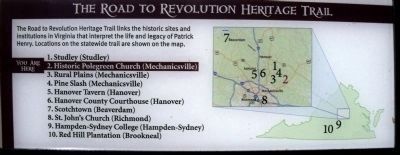
5. The Road to Revolution Heritage Trail
The Road to Revolution Heritage Trail links the historic sites and institutions in Virginia that interpret the life and legacy of Patrick Henry. Locations on the statewide trail are shown on the map.
1. Studley (Studley)
2. Historic Polegreen Church (Mechanicsville)
3. Rural Plains (Mechanicsville)
4. Pine Slash (Mechanicsville)
5. Hanover Tavern (Hanover)
6. Hanover County Courthouse (Hanover)
7. Scotchtown (Beaverdam)
8. St. John’s Church (Richmond)
9. Hampden-Sydney College (Hampden-Sydney)
10. Red Hill Plantation (Brookneal)
1. Studley (Studley)
2. Historic Polegreen Church (Mechanicsville)
3. Rural Plains (Mechanicsville)
4. Pine Slash (Mechanicsville)
5. Hanover Tavern (Hanover)
6. Hanover County Courthouse (Hanover)
7. Scotchtown (Beaverdam)
8. St. John’s Church (Richmond)
9. Hampden-Sydney College (Hampden-Sydney)
10. Red Hill Plantation (Brookneal)
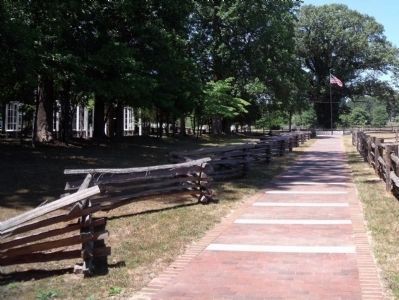
Photographed By Bernard Fisher, July 4, 2010
6. Polegreen Walk of Religious Liberty
64–304 Rome begins persecution of Jews and Christians but the underground Christian church thrives
312 Emperor Constantine converts to Christianity and allows limited religious toleration
391 Christianity becomes official religion of Rome
1478 Spanish Inquisition begins persecution of Jews and heretics
1490s Spain expels Muslims and Portugal expels Jews
1517 Martin Luther nails his 95 theses to the door of church at Wittenberg
1534 King Henry VIII renounces papal authority and becomes head of the Church of England
1541 John Calvin introduces Protestant Reformation to Geneva
1572 St. Bartholomew’s Day massacre of Protestants in France
1598 King Henry IV in France issues the Edict of Nantes granting Protestants freedom of worship
1607 English colonize Virginia and establish the Church of England as the official church
1620s–1640s Separatist Pilgrims and Puritans colonize New England
1660 Virginia House of Burgesses passes first laws restricting religious liberty of Quakers
1685 King Louis XIV in France rescinds the Edict of Nantes, prompting a mass exodus of Huguenots
1689 John Locke authors A Letter Concerning Toleration that becomes a foundation in the quest for religious freedom
1689 English Parliament passes the Act of Toleration allowing Protestants dissenting from the Church of England limited freedom of worship
1699 Virginia House of Burgesses confirms the Act of Toleration
1699 Presbyterian minister Francis Makemie is licensed to preach in Accomack County
1700 French Protestant refugees, called Huguenots, settle on the James River west of Richmond
1740 First Great Awakening comes to Virginia with the preaching of George Whitefield
1740s Samuel Morris, David Rice, Stephen Leacy and Thomas Watkins lead meetinghouses in Hanover County and vicinity
1743 William (One Eye) Robinson, Presbyterian missionary from New Castle, Pa, preaches at Samuel Morris’s Polegreen meetinghouse
1747 Presbyterian minister Samuel Davies is licensed to preach by Governor William Gooch
1748-1755 Presbyterian dissenters in central Virginia are harassed by the established Anglican Church
1748-1759 Samuel Davies becomes minister at Polegreen and preaches elsewhere in central Virginia. Patrick Henry hears Davies preach at Polegreen
1754- 1759 During the French and Indian War, Governor Robert Dinwiddie names Samuel Davies the best military recruiter in the colony
1755 Hanover Presbytery is founded here at Polegreen
1758 Presbyterians are assured by Governor Faquier that their rights will be respected
1776 Virginia’s Revolutionary Convention adopts Declaration of Rights guaranteeing free exercise of religion
1776 George Washington leads Colonial and French forces in revolution against English rule
1776 Baptists in Virginia begin campaign to disestablish the Church of England
1785 James Madison authors A Memorial and Remonstrance Against Religious Assessments promoting the free exercise of religion
1786 Virginia Statute for Religious Freedom, authored by Thomas Jefferson, is adopted
1791 Virginia General Assembly ratifies Bill of Rights; First Amendment to U.S. Constitution guarantees free exercise of religion
312 Emperor Constantine converts to Christianity and allows limited religious toleration
391 Christianity becomes official religion of Rome
1478 Spanish Inquisition begins persecution of Jews and heretics
1490s Spain expels Muslims and Portugal expels Jews
1517 Martin Luther nails his 95 theses to the door of church at Wittenberg
1534 King Henry VIII renounces papal authority and becomes head of the Church of England
1541 John Calvin introduces Protestant Reformation to Geneva
1572 St. Bartholomew’s Day massacre of Protestants in France
1598 King Henry IV in France issues the Edict of Nantes granting Protestants freedom of worship
1607 English colonize Virginia and establish the Church of England as the official church
1620s–1640s Separatist Pilgrims and Puritans colonize New England
1660 Virginia House of Burgesses passes first laws restricting religious liberty of Quakers
1685 King Louis XIV in France rescinds the Edict of Nantes, prompting a mass exodus of Huguenots
1689 John Locke authors A Letter Concerning Toleration that becomes a foundation in the quest for religious freedom
1689 English Parliament passes the Act of Toleration allowing Protestants dissenting from the Church of England limited freedom of worship
1699 Virginia House of Burgesses confirms the Act of Toleration
1699 Presbyterian minister Francis Makemie is licensed to preach in Accomack County
1700 French Protestant refugees, called Huguenots, settle on the James River west of Richmond
1740 First Great Awakening comes to Virginia with the preaching of George Whitefield
1740s Samuel Morris, David Rice, Stephen Leacy and Thomas Watkins lead meetinghouses in Hanover County and vicinity
1743 William (One Eye) Robinson, Presbyterian missionary from New Castle, Pa, preaches at Samuel Morris’s Polegreen meetinghouse
1747 Presbyterian minister Samuel Davies is licensed to preach by Governor William Gooch
1748-1755 Presbyterian dissenters in central Virginia are harassed by the established Anglican Church
1748-1759 Samuel Davies becomes minister at Polegreen and preaches elsewhere in central Virginia. Patrick Henry hears Davies preach at Polegreen
1754- 1759 During the French and Indian War, Governor Robert Dinwiddie names Samuel Davies the best military recruiter in the colony
1755 Hanover Presbytery is founded here at Polegreen
1758 Presbyterians are assured by Governor Faquier that their rights will be respected
1776 Virginia’s Revolutionary Convention adopts Declaration of Rights guaranteeing free exercise of religion
1776 George Washington leads Colonial and French forces in revolution against English rule
1776 Baptists in Virginia begin campaign to disestablish the Church of England
1785 James Madison authors A Memorial and Remonstrance Against Religious Assessments promoting the free exercise of religion
1786 Virginia Statute for Religious Freedom, authored by Thomas Jefferson, is adopted
1791 Virginia General Assembly ratifies Bill of Rights; First Amendment to U.S. Constitution guarantees free exercise of religion
Credits. This page was last revised on March 27, 2018. It was originally submitted on July 5, 2010, by Bernard Fisher of Richmond, Virginia. This page has been viewed 1,605 times since then and 47 times this year. Photos: 1, 2, 3, 4, 5, 6. submitted on July 5, 2010, by Bernard Fisher of Richmond, Virginia.
